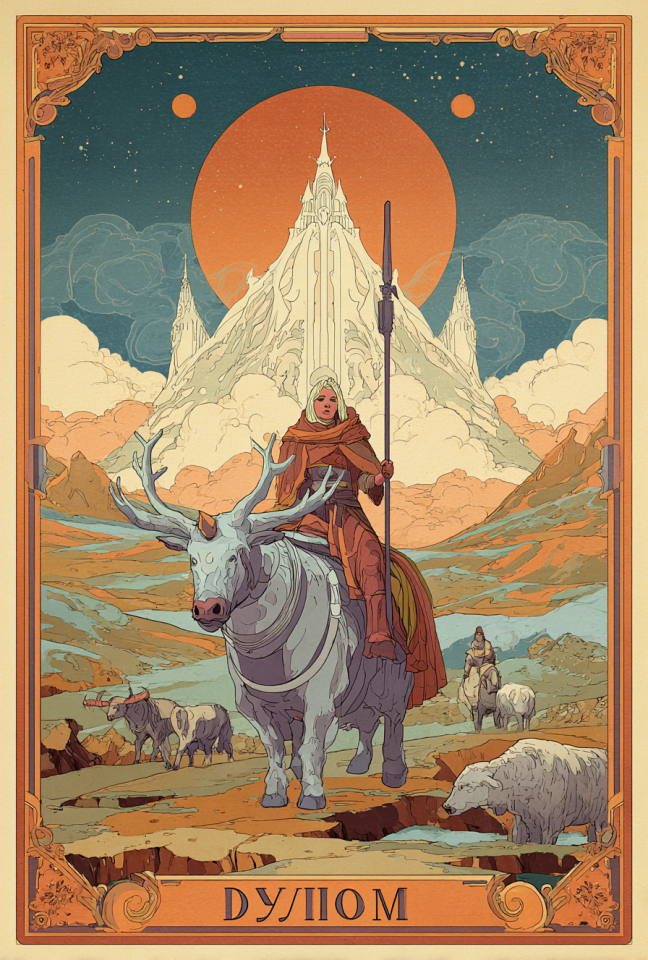Dyughóm (DYEU-ghohm)
The First Plain
Dyughóm is the primordial field — a Divine Realm of elemental resonance, where the Sky Father and Earth Mother remain eternally bound in sacred opposition and union. Governed by Dyēus whose name echoes in Zeus, Dyaus, and Tiwaz, and Dheghōm the warm, fertile earth whose breath gives rise to fire and form, Dyughóm is not a domain of thrones and courts, but of laws older than law. It is the pre-language the raw principle. From its vastness arose the framework of later pantheons — its symmetry encoded into the DNA of gods yet unborn. The realm persists now beyond the Veil, veiled not by cultural amnesia but by the sheer antiquity of its vibration, which only the eldest divine minds still recall.
Landscape and Essence
Dyughóm is a boundless convergence of land and sky, where there are no cities, no temples — only vast open steppe lit by stars that sing. The ground hums with warmth and fertility, patterned in shifting roots of red ochre and obsidian. The sky pulses with layered shades of blue, through which lightning veins in constant motion. Great fires burn at the center of stone circles, their flames neither consuming nor consuming — eternal hearths lit at the beginning of all things. Rivers run in mirrored paths, reflecting constellations whose names have not yet been spoken. Mountains rise slowly like breath inhaled. There is no silence here, only the hum of origin — a language older than words.Inhabitants
The twin rulers of Dyughóm are Dyēus the bright Sky Father, and Dheghōm the deep Earth Mother. They are not lovers in a romantic sense, but cosmic partners whose intercourse is the pulse of creation. Dyēus manifests as storm and structure, as rhythm and reckoning — the original lawgiver. Dheghōm is presence, patience, fertility, and flame — the forge beneath the soil, the womb of materiality. Their children are the archetypes of gods to come: the storm-bringer, the hearth-tender, the horse-lord, the twin-warriors. They dwell not in hierarchy but in mythic archetype — living concepts rather than individuated beings. Ancestors of the Yamnaya who passed through sacred rites walk here in skeletal dignity, clothed in starlight and ash.Cultural Significance
To the Yamnaya and other Proto-Indo-European peoples, Dyughóm was never written, only remembered — a sacred framework encoded in oral tradition, cosmology, and ritual. It is the reason hearths were placed at the center of homes, why oaths were sworn beneath open skies, why horses were offered at burial mounds. Dyughóm lived in gesture and arrangement : the division of three realms (sky, earth, underworld), the roles of warrior, priest, and farmer. It formed the core of what would later become Vedic, Greco-Roman, Norse, and Celtic pantheons — a cosmological seed from which many trees grew. As culture diverged and language specialized, Dyughóm was swallowed by its children but its resonance remained — a low chord under all mythic music.Role in the Divine Realm
Dyughóm is the first plain — the template realm the axis where the sacred tripartite model first coalesced. It offers no specific dogma, but defines balance : between male and female, structure and fertility, sky and soil. It is the realm where divine roles originate and where the concept of sovereignty itself first found footing. In the wider Divine Realm, Dyughóm is revered and rarely visited — not because it is hostile, but because its essence is so vast, so basal, that few gods can withstand its totality. It is the uninterpreted truth before narrative, before ritual.Interactions with Other Realms
Dyughóm once bled easily into the Mortal Realm — the wind on the steppe, the heat in the forge, the moment of childbirth. Priests, chieftains, and seers aligned their lives to its cadence through ritual geometry and recitation of sacred syllables. Mortals didn’t enter Dyughóm; they aligned with it. But as cultures fractured and evolved, the understanding of the original pattern weakened. Now, only those gods or mortals who remember the root language — the unspoken truths — can sense its hum. The Veil did not close in anger; it faded into quiet.
Type
Dimensional plane
Location under
Owner/Ruler
Additional Rulers/Owners
















